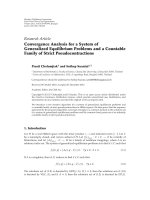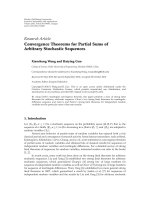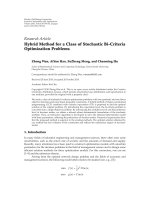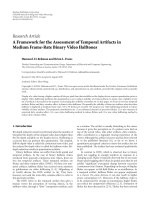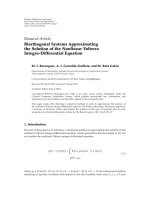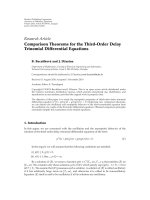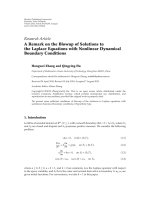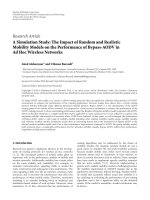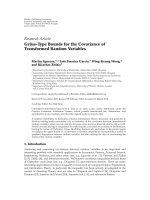báo cáo hóa học:" Research Article ¨ Gruss-Type Bounds for the Covariance of Transformed Random Variables" potx
Bạn đang xem bản rút gọn của tài liệu. Xem và tải ngay bản đầy đủ của tài liệu tại đây (510.53 KB, 10 trang )
Hindawi Publishing Corporation
Journal of Inequalities and Applications
Volume 2010, Article ID 619423, 10 pages
doi:10.1155/2010/619423
Research Article
Gr
¨
uss-Type Bounds for the Covariance of
Transformed Random Variables
Mart
´
ın Egozcue,
1, 2
Luis Fuentes Garc
´
ıa,
3
Wing-Keung Wong,
4
and Ri
ˇ
cardas Zitikis
5
1
Department of Economics, University of Montevideo, Montevideo 11600, Uruguay
2
Accounting and Finance Department, Norte Construcciones, Punta del Este 20100, Uruguay
3
Departamento de M
´
etodos Matem
´
aticos e de Representaci
´
on, Escola T
´
ecnica Superior de Enxe
˜
neiros
de Cami
˜
nos, Canais e Portos, Universidade da Coru
˜
na, 15001 A Coru
˜
na, Spain
4
Department of Economics, Institute for Computational Mathematics, Hong Kong Baptist University,
Kowloon Tong, Hong Kong
5
Department of Statistical and Actuarial Sciences, University of Western Ontario, London,
ON, Canada N6A 5B7
Correspondence should be addressed to Ri
ˇ
cardas Zitikis,
Received 9 November 2009; Revised 28 February 2010; Accepted 16 March 2010
Academic Editor: Soo Hak Sung
Copyright q 2010 Mart
´
ın Egozcue et al. This is an open access article distributed under the
Creative Commons Attribution License, which permits unrestricted use, distribution, and
reproduction in any medium, provided the original work is properly cited.
A number of problems in Economics, Finance, Information Theory, Insurance, and generally in
decision making under uncertainty rely on estimates of the covariance between transformed
random variables, which can, for example, be losses, risks, incomes, financial returns, and so forth.
Several avenues relying on inequalities for analyzing the covariance are available in the literature,
bearing the names of Chebyshev, Gr
¨
uss, Hoeffding, Kantorovich, and others. In the present paper
we sharpen the upper bound of a Gr
¨
uss-type covariance inequality by incorporating a notion of
quadrant dependence between random variables and also utilizing the idea of constraining the
means of the random variables.
1. Introduction
Analyzing and estimating covariances between random variables is an important and
interesting problem with manifold applications to Economics, Finance, Actuarial Science,
Engineering, Statistics, and other areas see, e.g., Egozcue et al. 1, Furman and Zitikis
2–5, Zitikis 6, and references therein. Well-known covariance inequalities include those
of Chebyshev and Gr
¨
uss see, e.g., Dragomir 7 and references therein. There are many
interesting applications of Gr
¨
uss’s inequality in areas such as Computer Science, Engineering,
and Information Theory. In particular, the inequality has been actively investigated in the
context of Guessing Theory, and we refer to Dragomir and Agarwal 8, Dragomir and
Diamond 9, Izumino and Pe
ˇ
cari
´
c 10, Izumino et al. 11, and references therein.
2 Journal of Inequalities and Applications
Motivated by an open problem posed by Zitikis 6 concerning Gr
¨
uss’s bound in the
context of dependent random variables, in the present paper we offer a tighter Gr
¨
uss-type
bound for the covariance of two transformed random variables by incorporating a notion of
quadrant dependence and also utilizing the idea of constraining the means of the random
variables. To see how this problem arises in the context of insurance and financial pricing, we
next present an illustrative example. For further details and references on the topic, we refer
to Furman and Zitikis 2–5.
Let X be an insurance or financial risk, which from the mathematical point of view
is just a random variable. In this context, the expectation EX is called the net premium.
The insurer, wishing to remain solvent, naturally charges a premium larger than EX.As
demonstrated by Furman and Zitikis 2, 4, many insurance premiums can be written in the
form
π
w
X
E
Xw
X
E
w
X
,
1.1
where w is a nonnegative function, called the weight function, and so π
w
X is called the
weighted premium. It is well known Lehmann 12 that if the weight function w is non-
decreasing, then the inequality π
w
X ≥ EX holds, which is called the nonnegative loading
property in insurance. Note that when wx ≡ 1, then π
w
XEX. The weighted
premium π
w
X can be written as follows:
π
w
X
E
X
Cov
X, w
X
E
w
X
,
1.2
with the ratio on the right-hand side known as the loading. The loading is a nonnegative
quantity because the weight function w is non-decreasing. We want to know t he magnitude
of the loading, given what we might know or guess about the weight function w and
the random variable X. Solving this problem naturally leads to bounding the covariance
CovX, wX.
More generally, as noted by Furman and Zitikis 2, 4, we may wish to work with the
doubly weighted premium
π
v,w
X
E
v
X
w
X
E
w
X
.
1.3
The latter premium leads to the covariance CovvX,wX. Finally, in the more general
context of capital allocations, the weighted premiums are extended into weighted capital
allocations Furman and Zitikis 3–5, which are
π
v,w
X, Y
E
v
X
w
Y
E
w
Y
E
v
X
Cov
v
X
,w
Y
E
w
Y
,
1.4
where the random variable Y can be viewed, for example, as the return on an entire portfolio
and X as the return on an asset in the portfolio. In Economics, EvX is known as the
Journal of Inequalities and Applications 3
expected utility, or the expected valuation, depending on a context. The ‘loading’ ratio on
the right-hand side of 1.4 can be negative, zero, or positive, depending on the dependence
structure between the random variables X and Y , and also depending on the monotonicity
of functions v and w. Our research in this paper is devoted to understanding the covariance
CovvX,wY and especially its magnitude, depending on the information that might be
available to the researcher and/or decision maker.
The rest of the paper is organized as follows. In Section 2 we discuss a number of
known results, which we call propositions throughout the section. Those propositions lead
naturally to our main result, which is formulated in Section 3 as Theorem 3.1.InSection 4
we give an illustrative example that demonstrates the sharpness of the newly established
Gr
¨
uss-type bound.
2. A Discussion of Known Results
Gr
¨
uss 13 proved that if two functions v and w satisfy bounds a ≤ vx ≤ A and b ≤ wx ≤
B for all x ∈ x
1
,x
2
, then
1
x
2
− x
1
x
2
x
1
v
x
w
x
dx −
1
x
2
− x
1
2
x
2
x
1
v
x
dx
x
2
x
1
w
x
dx
≤
1
4
A − a
B − b
. 2.1
This is known in the literature as the Gr
¨
uss bound. If X denotes a uniformly distributed
random variable with the support x
1
,x
2
, then statement 2.1 can be rewritten as
|
Cov
v
X
,w
X
|
≤
1
4
A − a
B − b
.
2.2
This is a covariance bound. If we replace vX and wX by two general random variables X
and Y with supports a, A and b, B, respectively, then from 2.2 we obtain the following
covariance bound Dragomir 14, 15; also Zitikis 6:
|
Cov
X, Y
|
≤
1
4
A − a
B − b
.
2.3
We emphasize that the random variables X and Y in 2.3 are not necessary uniformly
distributed. They are general random variables, except that we assume X ∈ a, A and
Y ∈ b, B, and no dependence structure between X and Y is assumed.
There are many results sharpening Gr
¨
uss’s bound under various bits of additional
information see, e.g., Dragomir 14, 15, and references therein. For example, Anastassiou
and Papanicolaou 16 have established the following bound.
Proposition 2.1. Let X ∈ a, A and Y ∈ b, B be two random variables with joint density function
h, assuming that it exists, and denote the (marginal) densities of X and Y by f and g, respectively.
Then
|
Cov
X, Y
|
≤
B
b
A
a
h
x, y
− f
x
g
y
dx dy
4
A − a
B − b
.
2.4
4 Journal of Inequalities and Applications
Approaching the problem from a different angle, Zitikis 6 has sharpened Gr
¨
uss’s
bound by including restrictions on the means of the random variables X and Y, as stated in
the next proposition.
Proposition 2.2. Let X ∈ a, A and Y ∈ b, B be two random variables. Furthermore, let
μ
a
,μ
A
⊆ a, A and μ
b
,μ
B
⊆ b, B be intervals such that EX ∈ μ
a
,μ
A
and EY ∈ μ
b
,μ
B
.
Then
|
Cov
X, Y
|
≤
1 − A
1 − B
4
A − a
B − b
,
2.5
where A and B are “information coefficients” defined by
A 1 −
2
A − a
sup
x∈μ
a
,μ
A
A − x
x − a
,
B 1 −
2
B − b
sup
y∈μ
b
,μ
B
B − y
y − b
.
2.6
When there is no “useful information,” then the two information coefficients A and B
are equal to 0 by definition Zitikis 6, and thus bound 2.5 reduces to the classical Gr
¨
uss
bound.
Mitrinovi
´
cetal.17 have in detail discussed Chebyshev’s integral inequality,
formulated next as a proposition, which gives an insight into Gr
¨
uss’s inequality and
especially into the sign of the covariance CovX, Y.
Proposition 2.3. Let v, w, and f be real functions defined on x
1
,x
2
, and let f be nonnegative and
integrable. If the functions v and w are both increasing, or both decreasing, then
x
2
x
1
f
x
dx ×
x
2
x
1
v
x
w
x
f
x
dx ≥
x
2
x
1
v
x
f
x
dx ×
x
2
x
1
w
x
f
x
dx.
2.7
If, however, one of the two functions v and w is increasing and the other one is decreasing, then
inequality 2.7 is reversed.
With an appropriately defined random variable X see a note following Gr
¨
uss’s
inequality 2.1 above, Chebyshev’s integral inequality 2.7 can be rewritten in the
following form:
Cov
v
X
,w
X
≥ 0. 2.8
As we will see in a moment, inequality 2.8 is also implied by the notion of positive quadrant
dependence Lehmann 12. For details on economic applications of Chebyshev’s integral
inequality 2.8, we refer to Athey 18, Wagener 19, and references therein.
Journal of Inequalities and Applications 5
There have been many attempts to express the covariance CovX, Y in terms of the
cumulative distribution functions of the random variables X and Y . Among them is a result
by Hoeffding 20, who proved that
Cov
X, Y
H
x, y
− F
x
G
y
dx dy, 2.9
where H is the j oint cumulative distribution function of X, Y ,andF and G are the
marginal cumulative distribution functions of X and Y , respectively. Mardia 21,Mardia
and Thompson 22 extended Hoeffding’s result by showing that
Cov
X
r
,Y
s
H
x, y
− F
x
G
y
rx
r−1
sy
s−1
dx dy. 2.10
For further extensions of these results, we refer to Sen 23 and Lehmann 12. Cuadras 24
has generalized these works by establishing the following result.
Proposition 2.4. Let v and w be any real functions of bounded variation and defined, respectively,
on the intervals a, A and b, B of the extended real line −∞, ∞. Furthermore, let X ∈ a, A and
Y ∈ b, B be any random variables such that the expectations EvX, EwY , and EvXwY
are finite. Then
Cov
v
X
,w
Y
b,B
a,A
H
x, y
− F
x
G
y
dv
x
dw
y
.
2.11
Equation 2.11 plays a crucial role in establishing our main result, which is
Theorem 3.1 in the next section. To facilitate easier intuitive understanding of that section,
we note that the function
C
x, y
H
x, y
− F
x
G
y
, 2.12
which is the integrand on the right-hand side of 2.11, governs the dependence structure
between the random variables X and Y. For example, when Cx, y0 for all x and y,
then the random variables are independent. Hence, departure of Cx, y from 0 serves a
measure of dependence between X and Y . Depending on which side positive or negative
the departure from 0 takes place, we have positive or negative dependence between the two
random variables. Specifically, when Cx, y ≥ 0 for all x and y, then X
and Y are called
positively quadrant dependent, and when Cx, y ≤ 0 for all x and y, then the random
variables are negatively quadrant dependent. For applications of these notions of dependence
and also for further references, we refer to the monographs by Balakrishnan and Lai 25,
Denuit et al. 26.
6 Journal of Inequalities and Applications
3. A New Gr
¨
uss-Type Bound
We start this section with a bound that plays a fundamental role in our subsequent
considerations. Namely, for all x, y ∈ R, we have that
C
x, y
≤
1
4
3.1
irrespectively of the dependence structure between the random variables X and Y . Bound
3.1 can be verified as follows. First, for any event A, the probability PA is the expectation
E1{A} of the indicator 1{A}, which is a random variable taking on the value 1 if the event A
happens, and 0 otherwise. Hence, Cx, y is equal to the covariance Cov1{X ≤ x}, 1{Y ≤ y}.
Next we use the Cauchy-Schwarz inequality to estimate the latter covariance and thus obtain
that
C
x, y
≤
Var
1
{
X ≤ x
}
Var
1
Y ≤ y
.
3.2
Since 1{X ≤ x} is a binary random variable taking on the two values 1 and 0 with the
probabilities PX ≤ x and PX>x, respectively, the variance Va r1{X ≤ x} is equal to
the product of the probabilities PX ≤ x and PX>x. The product does not exceed 1/4.
Likewise, the variance Var1{Y ≤ y} does not exceed 1/4. From bound 3.2 we thus have
bound 3.1.
To see how bound 3.1 is related to Gr
¨
uss’s bound, we apply it on the right-hand side
of 2.11. We also assume that the functions v
and w are right-continuous and monotonic.
Note that, without loss of generality in our context, the latter monotonicity assumption can
be replaced by the assumption that the two functions v and w are non-decreasing. Hence, we
have the bound
|
Cov
v
X
,w
Y
|
≤
1
4
v
A
− v
a
w
B
− w
b
,
3.3
which is Gr
¨
uss’s bound written in a somewhat different form than that in 2.2.
The following theorem sharpens the upper bound of Gr
¨
uss’s covariance inequality
3.3 by utilizing the notion of quadrant dependence cf. Lehmann 12 and incorporating
constrains on the means of random variables X and Y cf. Zitikis 6.
Theorem 3.1. Let X ∈ a, A and Y ∈ b, B be any random variables, and let D ∈ 0, 1, which one
calls the “dependence coefficient,” be such that
C
x, y
≤
1 − D
4
3.4
for all x ∈ a, A and y ∈ b, B. Furthermore, let v and w be two right-continuous and non-
decreasing functions defined on a, A and b, B, respectively, and let Ω
1
and Ω
2
be intervals such
that EvX ∈ Ω
1
⊆ va,vA and EwY ∈ Ω
2
⊆ wb,wB.Then
|
Cov
v
X
,w
Y
|
≤
min
{
1 − D,
1 − A
1 − B
}
4
v
A
− v
a
w
B
− w
b
,
3.5
Journal of Inequalities and Applications 7
where A and B are “information coefficients” defined by
A 1 −
2
v
A
− v
a
sup
x∈Ω
1
v
b
− x
x − v
a
,
B 1 −
2
w
B
− w
b
sup
y∈Ω
2
w
B
− y
y − w
b
.
3.6
Before proving the theorem, a few clarifying notes follow. If there is no “useful
information” see Zitikis 6 for the meaning about the location of the means EvX
and EwY inside the intervals va,vA and wb,wB, respectively, then the two
information coefficients A and B are equal to 0 by definition, and thus 1 − A1 − B is
equal to 1. Furthermore, if there is no “useful dependence information” between X and Y ,
then D 0 by definition. Hence, in the presence of no “useful information” about the means
and dependence, the coefficient min{1 − D, 1 − A
1 − B}/4 reduces to the classical Gr
¨
uss
coefficient 1/4.
Proof of Theorem 3.1. Since |Cx, y|≤1 − D/4 by assumption, using 2.11 we have that
|
Cov
v
X
,w
Y
|
≤
b,B
a,A
C
x, y
dv
x
dw
y
≤
1 − D
4
b,B
a,A
dv
x
dw
y
1 − D
4
v
A
− v
a
w
B
− w
b
,
3.7
where the last equality holds because the functions v and w are right-continuous and non-
decreasing. Next we restart the estimation of the covariance CovvX,wY anew. Namely,
using the Cauchy-Schwarz inequality, together with the bound
Cov
v
X
,v
X
≤
v
A
− E
v
X
E
v
X
− v
a
3.8
and an analogous one for CovwY ,wY ,weobtainthat
|
Cov
v
X
,w
Y
|
≤
Cov
v
X
,v
X
Cov
w
Y
,w
Y
≤ sup
x∈Ω
1
v
A
− x
x − v
a
sup
y∈Ω
2
w
B
− y
y − w
b
1 − A
1 − B
4
v
A
− v
a
w
B
− w
b
.
3.9
Combining bounds 3.7 and 3.9, we arrive at bound 3.5, thus completing the proof of
Theorem 3.1.
8 Journal of Inequalities and Applications
4. An Example
Here we present an example that helps to compare the bounds of Gr
¨
uss 13, Zitikis 6,and
the one of Theorem 3.1.
To make our considerations as simple as possible, yet meaningful, we choose to work
with the f unctions vxx and wyy, and also assume that the random variables X and
Y take on values in the interval 0, 1.Gr
¨
uss’s bound 2.3 implies that
|
Cov
X, Y
|
≤
1
4
0.25.
4.1
Assume now t hat the pair X, Y has a joint density function, fs, t,andletitbeequal
to s
2
t
2
3/2fors, t ∈ 0, 1, and 0 for all other s, t ∈ R. The random variables X and Y take
on values in the interval 0, 1 as before, but we can now calculate their means and thus apply
Proposition 2.2 with appropriately specified “μ-constraints.”
The joint cumulative distribution function Hx, y
y
0
x
0
fs, tdsdt of the pair X, Y
can be expressed by the formula Hx, yxyx
2
y
2
/2. Thus, the marginal cumulative
distribution functions of X and Y are equal to FxHx, 1xx
2
1/2 for all x ∈ 0, 1
and GyH1,yyy
2
1/2 for all y ∈ 0, 1, respectively. Using the equation EX
1
0
1 − Fxdx, we check that EX5/8. Likewise, we have EY5/8. Consequently,
we may let the μ-constraints on the means EX and EY be as follows: μ
a
5/8 μ
A
and μ
b
5/8 μ
B
. We also have a 0 b and A 1 B, because 0, 1 is the support
of the two random variables X and Y. These notes and the definitions of A and B given in
Proposition 2.2 imply that 1 − A 1 − B
15/16. Consequently, bound 2.5 implies that
|
Cov
X, Y
|
≤
15
64
0.2344,
4.2
which is an improvement upon bound 4.1, and thus upon 4.2.
We next utilize the dependence structure between X and Y in order to further improve
upon bound 4.2.WithA and B already calculated, we next calculate D. For this, we use
the above formulas for the three cumulative distribution functions and see that Cx, y
xyx
2
−11 −y
2
/4. The negative sign of Cx, y for all x, y ∈ 0, 1 reveals that the random
variables X and Y are negatively quadrant dependent. Furthermore, we check that |Cx, y|
attains its maximum at the point 1/
√
3, 1/
√
3. Hence, the smallest upper bound for |Cx, y|
is 1/27, and so we have 1 −D 4/27, which is less than 1−A1 −B15/16. Hence, bound
3.5 implies that
|
Cov
X, Y
|
≤
1
27
0.0370,
4.3
which is a considerable improvement upon bounds 4.1 and 4.2.
We conclude this example by noting that the true value of the covariance CovX, Y is
Cov
X, Y
−
1
64
−0.0156,
4.4
Journal of Inequalities and Applications 9
which we have calculated using the equation CovX, Y
1
0
1
0
Cx, ydx dy cf. 2.9 and
the above given expression for Cx, y.
Acknowledgments
The authors are indebted to four anonymous referees, the editor in charge of the manuscript,
Soo Hak Sung, and the Editor-in-Chief, Ravi P. Agarwal, for their constructive criticism
and numerous suggestions that have resulted in a considerable improvement of the paper.
The third author would also like to thank Robert B. Miller and Howard E. Thompson for
their continuous guidance and encouragement. The research has been partially supported
by grants from the University of Montevideo, University of Coru
˜
na, Hong Kong Baptist
University, and the Natural Sciences and Engineering Research Council NSERC of Canada.
References
1 M. Egozcue, L. Fuentes Garcia, and W K. Wong, “On some covariance inequalities for monotonic and
non-monotonic functions,” Journal of Inequalities in Pure and Applied Mathematics, vol. 10, no. 3, article
75, pp. 1–7, 2009.
2 E. Furman and R. Zitikis, “Weighted premium calculation principles,” Insurance: Mathematics and
Economics, vol. 42, no. 1, pp. 459–465, 2008.
3 E. Furman and R. Zitikis, “Weighted risk capital allocations,” Insurance: Mathematics and Economics,
vol. 43, no. 2, pp. 263–269, 2008.
4 E. Furman and R. Zitikis, “Weighted pricing functionals with applications to insurance: an overview,”
North American Actuarial Journal, vol. 13, pp. 483–496, 2009.
5 E. Furman and R. Zitikis, “General Stein-type covariance decompositions with applications to
insurance and Finance,” to appear in ASTIN Bulletin—The Journal of the International Actuarial
Association.
6 R. Zitikis, “Gr
¨
uss’s inequality, its probabilistic interpretation, and a sharper bound,” Journal of
Mathematical Inequalities, vol. 3, no. 1, pp. 15–20, 2009.
7 S. S. Dragomir, Advances in Inequalities of the Schwarz, Gr
¨
uss and Bessel Type in Inner Product Spaces,
Nova Science, New York, NY, USA, 2005.
8 S. S. Dragomir and R. P. Agarwal, “Some inequalities and their application for estimating the
moments of guessing mappings,” Mathematical and Computer Modelling, vol. 34, no. 3-4, pp. 441–468,
2001.
9 S. S. Dragomir and N. T. Diamond, “A discrete Gr
¨
uss type inequality and applications for the
moments of random variables and guessing mappings,” in Stochastic Analysis and Applications, vol.
3, pp. 21–35, Nova Science, New York, NY, USA, 2003.
10 S. Izumino and J. E. Pe
ˇ
cari
´
c, “Some extensions of Gr
¨
uss’ inequality and its applications,” Nihonkai
Mathematical Journal, vol. 13, no. 2, pp. 159–166, 2002.
11 S. Izumino, J. E. Pe
ˇ
cari
´
c, and B. Tepe
ˇ
s, “A Gr
¨
uss-type inequality and its applications,” Journal of
Inequalities and Applications, vol. 2005, no. 3, pp. 277–288, 2005.
12 E. L. Lehmann, “Some concepts of dependence,” Annals of Mathematical Statistics, vol. 37, pp. 1137–
1153, 1966.
13 G. Gr
¨
uss, “
¨
Uber das maximum des absoluten betrages von 1/b − a
b
a
fxgxdx −
1/b − a
2
b
a
fxdx
b
a
gxdx,” Mathematische Zeitschrift, vol. 39, no. 1, pp. 215–226, 1935.
14 S. S. Dragomir, “A generalization of Gr
¨
uss’s inequality in inner product spaces and applications,”
Journal of Mathematical Analysis and Applications, vol. 237, no. 1, pp. 74–82, 1999.
15 S. S. Dragomir, “New inequalities of the Kantorovich type for bounded linear operators in Hilbert
spaces,” Linear Algebra and Its Applications, vol. 428, no. 11-12, pp. 2750–2760, 2008.
16 G. A. Anastassiou and V. G. Papanicolaou, “Probabilistic inequalities and remarks,” Applied
Mathematics Letters, vol. 15, no. 2, pp. 153–157, 2002.
17 D. S. Mitrinovi
´
c, J. E. Pe
ˇ
cari
´
c,andA.M.Fink,Classical and New Inequalities in Analysis, vol. 61 of
Mathematics and Its Applications (East European Series), Kluwer Academic Publishers, Dordrecht, The
Netherlands, 1993.
10 Journal of Inequalities and Applications
18 S. Athey, “Monotone comparative statics under uncertainty,” Quarterly Journal of Economics, vol. 117,
no. 1, pp. 187–223, 2002.
19 A. Wagener, “Chebyshev’s algebraic inequality and comparative statics under uncertainty,”
Mathematical Social Sciences, vol. 52, no. 2, pp. 217–221, 2006.
20 W. Hoeffding, “Masstabinvariante korrelationstheorie,” in Schriften des Matematischen Instituts f
¨
ur
Angewandte Matematik der Universit
¨
at Berlin, vol. 5, pp. 179–233, 1940.
21 K. V. Mardia, “Some contributions to contingency-type bivariate distributions,” Biometrika, vol. 54,
pp. 235–249, 1967.
22 K. V. Mardia and J. W. Thompson, “Unified treatment of moment-formulae,” Sankhy
¯
a Series A, vol. 34,
pp. 121–132, 1972.
23 P. K. Sen, “The impact of Wassily Hoeffding’s research on nonparametric,” in Collected Works of Wassily
Hoeffding, N. I. Fisher and P. K. Sen, Eds., pp. 29–55, Springer, New York, NY, USA, 1994.
24 C. M. Cuadras, “On the covariance between functions,” Journal of Multivariate Analysis, vol. 81, no. 1,
pp. 19–27, 2002.
25 N. Balakrishnan and C. D. Lai, Continuous Bivariate Distributions, Springer, New York, NY, USA, 2nd
edition, 2009.
26 M. Denuit, J. Dhaene, M. Goovaerts, and R. Kaas, Actuarial Theory for Dependent Risks: Measures, Orders
and Models, John Wiley & Sons, Chichester, UK, 2005.
